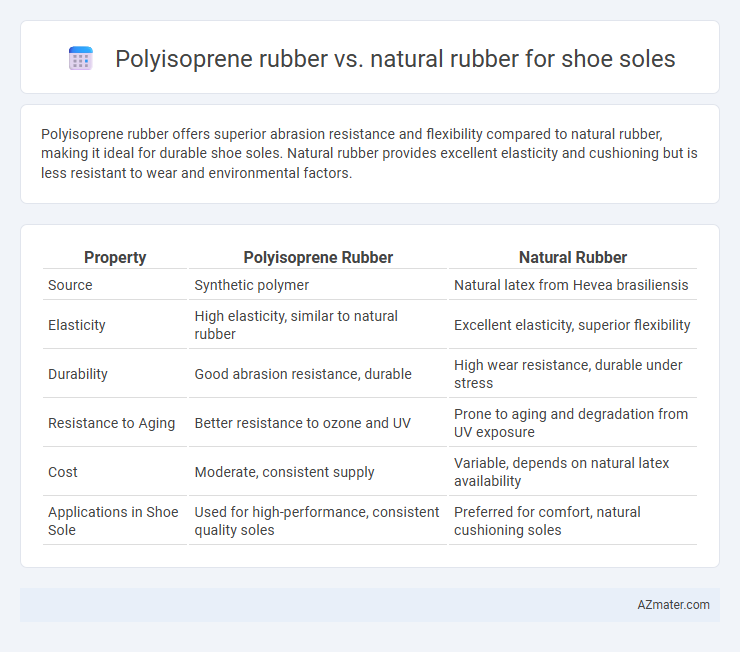Polyisoprene rubber offers superior abrasion resistance and flexibility compared to natural rubber, making it ideal for durable shoe soles. Natural rubber provides excellent elasticity and cushioning but is less resistant to wear and environmental factors.
Table of Comparison
| Property | Polyisoprene Rubber | Natural Rubber |
|---|---|---|
| Source | Synthetic polymer | Natural latex from Hevea brasiliensis |
| Elasticity | High elasticity, similar to natural rubber | Excellent elasticity, superior flexibility |
| Durability | Good abrasion resistance, durable | High wear resistance, durable under stress |
| Resistance to Aging | Better resistance to ozone and UV | Prone to aging and degradation from UV exposure |
| Cost | Moderate, consistent supply | Variable, depends on natural latex availability |
| Applications in Shoe Sole | Used for high-performance, consistent quality soles | Preferred for comfort, natural cushioning soles |
Introduction to Polyisoprene and Natural Rubber
Polyisoprene rubber, a synthetic elastomer chemically similar to natural rubber, offers enhanced uniformity and controlled polymer properties ideal for shoe sole applications. Natural rubber, derived from the latex of Hevea brasiliensis trees, provides excellent elasticity, resilience, and abrasion resistance essential for durable footwear. Comparing both, polyisoprene provides consistent quality and improved aging resistance, while natural rubber excels in high tensile strength and eco-friendly biodegradability.
Chemical Structure and Composition Differences
Polyisoprene rubber consists primarily of synthetic cis-1,4-polyisoprene chains, closely mimicking the molecular structure of natural rubber, which is mainly trans-1,4-polyisoprene with accompanying proteins and lipids. Unlike natural rubber's complex biological composition, polyisoprene rubber is free from proteins, reducing allergenic potential and providing more consistent polymer chain lengths. This structural purity translates to enhanced durability and uniform mechanical properties in shoe soles, while natural rubber offers superior elasticity and resilience due to its natural cross-linking and associated biomolecules.
Sourcing and Sustainability
Polyisoprene rubber, synthetically produced from petrochemical sources, offers consistent quality and reduces dependence on natural resources compared to natural rubber, which is harvested from rubber trees primarily in Southeast Asia and West Africa. Natural rubber presents sustainability challenges due to deforestation and land use changes but is biodegradable and renewable, whereas polyisoprene's production involves fossil fuels contributing to higher carbon emissions. Sustainable sourcing of natural rubber increasingly involves certification schemes like FSC and Rainforest Alliance, promoting responsible forestry and reduced environmental impact in shoe sole manufacturing.
Manufacturing Processes for Shoe Soles
Polyisoprene rubber offers greater consistency and purity in manufacturing shoe soles compared to natural rubber due to its synthetic production process, which allows precise control over polymerization and material properties. Natural rubber manufacturing involves tapping latex from rubber trees, followed by coagulation, drying, and vulcanization, making it more variable and labor-intensive. The synthetic process of polyisoprene reduces impurities and enhances durability, resulting in shoe soles with improved abrasion resistance and uniform elasticity.
Physical Properties: Durability and Flexibility
Polyisoprene rubber offers superior durability compared to natural rubber, making it ideal for shoe soles that require extended wear resistance. Its enhanced tensile strength and abrasion resistance ensure long-lasting performance under various conditions. Natural rubber provides excellent flexibility and elasticity, contributing to comfortable cushioning and a responsive feel during movement.
Performance in Various Weather Conditions
Polyisoprene rubber exhibits superior weather resistance compared to natural rubber, maintaining flexibility and durability in extreme temperatures and wet conditions, making it ideal for shoe soles exposed to variable climates. Natural rubber tends to degrade more rapidly under UV exposure and moisture, leading to decreased performance and shorter lifespan in harsh weather environments. Polyisoprene's enhanced oxidation and ozone resistance contribute to prolonged sole integrity and traction stability across diverse weather scenarios.
Comfort and Cushioning Capabilities
Polyisoprene rubber offers superior cushioning and resilience compared to natural rubber, enhancing overall shoe sole comfort by providing consistent shock absorption during prolonged wear. Its synthetic structure ensures better resistance to deformation and maintains softness under varying temperatures, which contributes to lasting comfort. Natural rubber, while flexible and eco-friendly, often shows quicker compression set and less consistent cushioning performance, potentially reducing long-term comfort in shoe soles.
Environmental Impact and Biodegradability
Polyisoprene rubber, a synthetic alternative resembling natural rubber, generally exhibits lower biodegradability due to its petrochemical origins, leading to prolonged environmental persistence in shoe sole applications. Natural rubber, derived from Hevea brasiliensis latex, offers higher biodegradability and a smaller ecological footprint, thanks to its renewable sourcing and biodegradation through microbial activity. Choosing natural rubber for shoe soles can thus reduce plastic waste and promote sustainable lifecycle management in the footwear industry.
Cost Comparison and Market Availability
Polyisoprene rubber offers a cost advantage over natural rubber due to more consistent production processes and lower price volatility, making it a preferred choice for budget-conscious shoe sole manufacturers. Market availability of polyisoprene is high, driven by synthetic production capacity, whereas natural rubber supply is subject to geographic and climatic fluctuations impacting price and accessibility. The economics of polyisoprene rubber improve supply chain stability and predictability in shoe sole manufacturing compared to the natural rubber market.
Choosing the Right Rubber for Shoe Soles
Polyisoprene rubber offers enhanced abrasion resistance and consistent quality, making it ideal for high-performance shoe soles that require durability and flexibility. Natural rubber provides excellent elasticity and good grip, preferred for comfort and traction in everyday footwear. Selecting between polyisoprene and natural rubber depends on balancing factors like wear resistance, resilience, and the intended use environment of the shoe sole.

Infographic: Polyisoprene rubber vs Natural rubber for Shoe sole
 azmater.com
azmater.com